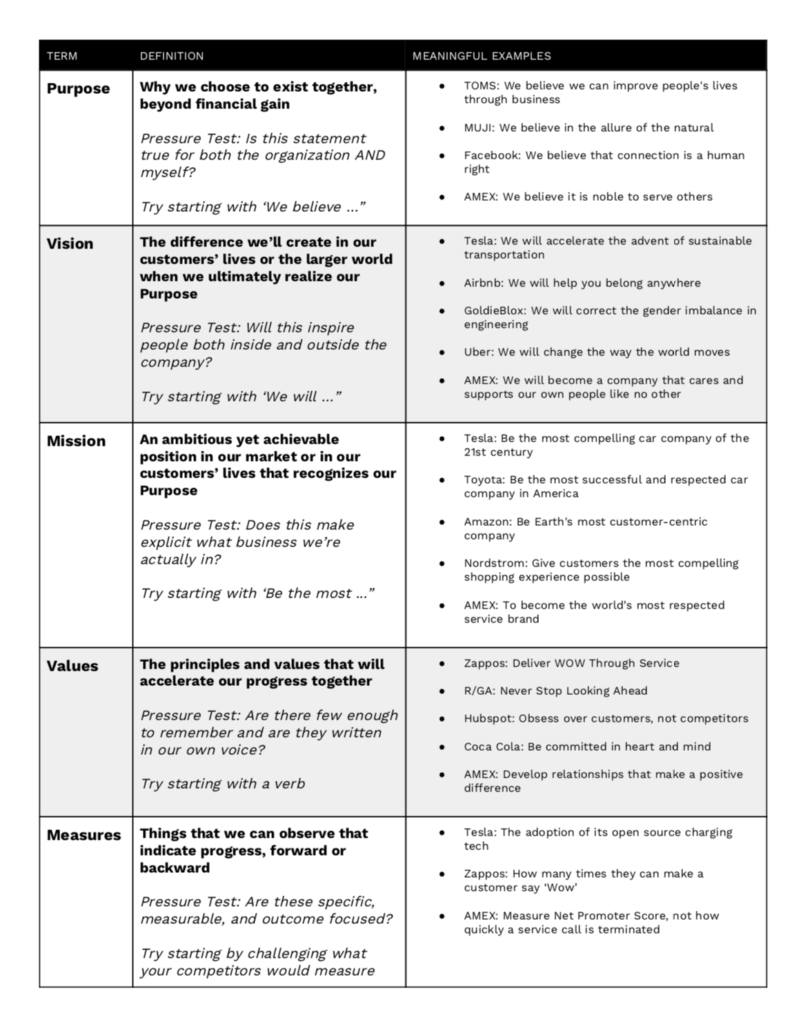As companies demand more out of their employees, top talent is demanding more from companies in terms of purpose and engagement—in fact, according to a 2015 Deloitte Survey, 6 out of 10 Millennials stated that they chose to work for their current employers due to their “sense of purpose.” It’s all too easy for a company’s Purpose, Vision, Mission, and Values to get muddled, so we’ve created a template to help your team understand the differences.

NOBL has helped world-famous organizations align employee behavior with visionary purpose. Reach out to see how we might be able to help your organization.
A Quick Overview of the Elements
- Purpose: Why you choose to exist together, beyond financial gain. A good way to test whether your Purpose is meaningful is to “gut check” whether it holds true for individuals as well as the organization as a whole. It usually starts with “We believe…”
- Vision: The difference you’ll create in your customers’ lives or the larger world when you ultimately realize your Purpose. The Vision should excite people both inside and outside the company. Try starting with “We will…”
- Mission: An ambitious yet achievable position in the market or in your customers’ lives that recognizes your Purpose. It should make clear which business you’re in, and often starts with the phrase “Be the most…”
- Values: The principles and values that will accelerate your progress together. These statements typically start with a verb, like “Be committed” or “Deliver excellence.” Successful values are limited (so they’re easier to remember) and written in the company’s voice.
- Measures: Things that you can observe that indicate progress. Though frequently left off of a Purpose statement, this may be the most useful feature, ensuring that all of the above will be a part of daily business, rather than just another poster on the wall. Look for measures that are specific and outcome-focused.
How to Define These For Your Organization
- Select your team. Field a diverse group from within the company to participate in the process. Don’t just pick senior leaders: select team members across skill sets and seniority who seem most emblematic of the company and its mission. Be sure to include at least one member of the team that is especially skilled in copywriting (words matter, after all).
- Generate values first. Ask the team to brainstorm the values (ethical principles or standard behaviors) that seem most critical to the success of the company. Ground the team by asking them to reflect on past projects and major milestones in the firm’s history.
- Rank those values. Ask the team to vote on which value is most rewarded internally and best represents the company’s most sacred belief about the world, its employees, and its customers. Purpose is nothing more than your most tightly held value as a company. If you find yourself stuck because the team prefers a value that feels transactional versus inspirational, instead of questioning the team, question the behaviors and principles that exist within the company.
- Assign your most important belief as your Purpose. Write out a simple sentence that begins with ‘We believe …’ Example: Meaningful work is a universal human right.
- Tell your Vision. If your Purpose is achieved, what will the world look like for your customers and communities? Example: We will ensure that everyone will have the opportunity to do work that matters.
- Declare your Mission. Your Mission is the work that must happen every single day to ensure that your Purpose accomplishes your Vision for the world, beginning with your unique role in the market. Example: Become a weekly resource for teams eager to change the way they work for the better.
- Revisit your Values. Based on your Vision and Mission, which of the Values you captured in Step Two will best accelerate your team’s progress? Select three to five values to record. Be sure to use language that feels most natural to your culture and people.
- Define progress with your Measures. How will you know that the organization is fulfilling its Purpose, Mission, and Values? What specific KPIs will mark progress along the way?
- Collect feedback on your draft. Share the team’s work internally and give everyone in the company 20-30 days to ask questions, offer reactions, and suggest improvements. Be curious, humble, and open to suggestions.
- Revise based on feedback and publish the results. Let the organization know that you listened to their feedback and answer any open questions. Develop collateral and swag as necessary to ensure that every employee has a firm grasp on the meaning behind their work.
- Revisit every six months. Reconvene the original team, plus any additional cultural torchbearers, every six months to assess whether the defined Purpose, Vision, Mission, Values, and Measures still accurately reflect the company overall. Ideally, Purpose and Vision should be evergreen. Mission may change based on the shape and condition of the market, overall. Values should then adapt based on the behaviors most critical to pushing work forward in the current competitive environment. Measures may change most frequently of all based on the Mission.









The Evolutionary Edge
Every Link Ever from Our Newsletter
Why Self-Organizing is So Hard
Welcome to the Era of the Empowered Employee
The Power of “What If?” and “Why Not?”
An Adaptive Approach to the Strategic Planning Process
Why Culture/Market Fit Is More Important than Product/Market Fit
Group Decision Making Model: How to Make Better Decisions as a Team